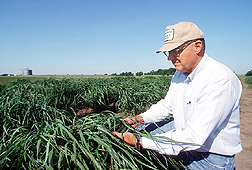More on Cellulosic Ethanol and Switchgrass
 Back in this posting, I discussed the scientific findings that cellulosic ethanol from switchgrass and other cellulose sources could produce as much as 8X the amount of energy utilised in their production. Since then, Carnegie Mellon University has studied the issue, and researchers there now say that switchgrass ethanol could substantially relax present energy bottlenecks.
Back in this posting, I discussed the scientific findings that cellulosic ethanol from switchgrass and other cellulose sources could produce as much as 8X the amount of energy utilised in their production. Since then, Carnegie Mellon University has studied the issue, and researchers there now say that switchgrass ethanol could substantially relax present energy bottlenecks."Our report indicates the time is right for America to begin a transition to ethanol derived from switchgrass," said Scott Matthews, an assistant professor in the Civil and Environmental Engineering Department. A 25 percent hike in gas prices at the pump since December adds to the researchers' call for more ethanol derived from switchgrass, a perennial tall grass used as forage for livestock. Gasoline prices in the U.S. are approaching an average of $3 a gallon. The Carnegie Mellon findings were published in the May 1 issue of the American Chemical Society's Journal "Environmental Science and Technology."
Matthews, along with W. Michael Griffin, executive director of the Green Design Institute at Carnegie Mellon's Tepper School of Business, and William R. Morrow, a researcher in the university's Department of Civil and Environmental Engineering, said using switchgrass as a supplement to corn to make ethanol would help ensure the availability of large volumes of inexpensive ethanol to fuel distributors and consumers.
"We need to be thinking about how we can make and deliver ethanol once our corn and land resources are maxed out. Switchgrass can be that next step," Griffin said.
The Carnegie Mellon report also found that ethanol derived from the dry, brown switchgrass, a cellulosic ethanol, could be made in sufficient quantities to deliver 16 percent ethanol fuel to all consumers in the U.S. Researchers said this would likely lead to significant decreases and stability in the price of gasoline.
"It's a renewable resource," Griffin said. "Rather than taking a depletable resource from the ground, switchgrass can be grown again and again."
In a recent address, President George W. Bush made a plea for increased focus on renewable energy, mentioning switchgrass by name.
Scientists have long known how to use enzymes and microorganisms to mine the carbon from carbohydrates to make industrial products. But for decades the technology didn't go very far commercially because fossil fuel – hydrocarbon – was a far cheaper carbon source.
Now that oil prices have climbed roughly 35 percent over the past year, cellulosic fermentation technology is becoming economical.
The United Nations Food and Agricultural Organization said last week that biofuels may supply 25 percent of the world's energy needs in 15 to 20 years.
"This shift from using hydrocarbons to carbohydrates could revolutionize many industries, including the nation's huge agricultural sector," Griffin said. Story source.
Personally, I prefer butanol over ethanol as a renewable substitute for gasoline. Most engineers would agree that the burning qualities of butanol are far closer to gasoline than those of ethanol. Nevertheless, the energy industry is driven by economics of supply and demand, and until better ways of fermenting butanol from cellulose are devised, it looks like ethanol (and perhaps methanol) will be the short to medium term winners in the renewable liquid fuel markets. Biodiesel is the dark horse candidate that might yet break from the pack.
Labels: butanol, cellulosic fuels

0 Comments:
Post a Comment
Subscribe to Post Comments [Atom]
<< Home